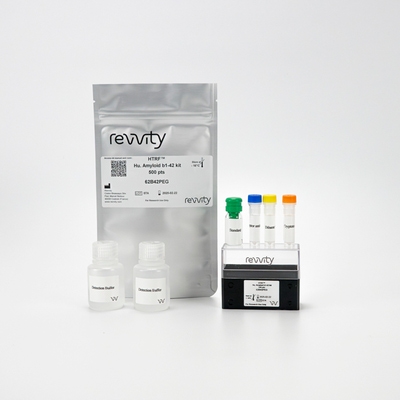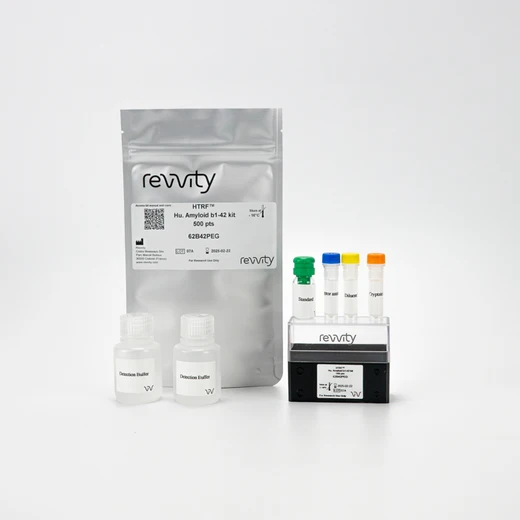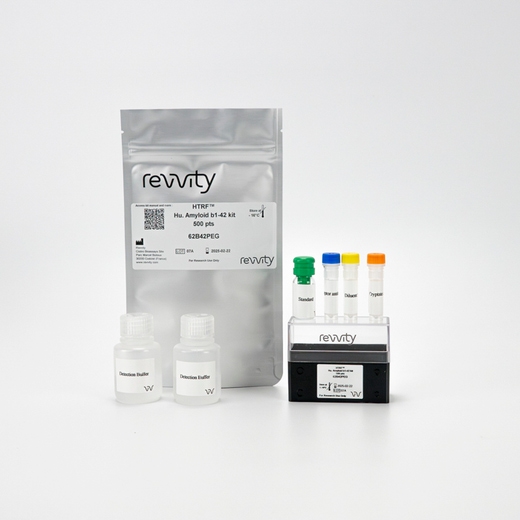

HTRF Human Amyloid β 1-42 Detection Kit, 500 Assay Points


HTRF Human Amyloid β 1-42 Detection Kit, 500 Assay Points






The Amyloid β 1-42 kit is designed for the simple and rapid quantification of the peptide in cell-based formats.
For research use only. Not for use in diagnostic procedures. All products to be used in accordance with applicable laws and regulations including without limitation, consumption and disposal requirements under European REACH regulations (EC 1907/2006).
| Feature | Specification |
|---|---|
| Application | Protein Quantification |
| Sample Volume | 16 µL |
The Amyloid β 1-42 kit is designed for the simple and rapid quantification of the peptide in cell-based formats.
For research use only. Not for use in diagnostic procedures. All products to be used in accordance with applicable laws and regulations including without limitation, consumption and disposal requirements under European REACH regulations (EC 1907/2006).



HTRF Human Amyloid β 1-42 Detection Kit, 500 Assay Points



HTRF Human Amyloid β 1-42 Detection Kit, 500 Assay Points



Product information
Overview
Amyloid β1-40 and β1-42 peptides are involved in the appearance of Alzheimer's Disease symptoms. The production of these two amyloid peptides is regulated by the activity of 2 enzymes, β and ƴ secretase, which cleave the amyloid precursor protein. This kit is intended to measure amyloid β1-42 peptides in cell supernatant or in whole cells. The assay is a fast alternative to ELISA, thanks to the easy implementation of our Add and Read method.
Specifications
| Application |
Protein Quantification
|
|---|---|
| Brand |
HTRF
|
| Detection Modality |
HTRF
|
| Lysis Buffer Compatibility |
Lysis Buffer 1
|
| Product Group |
Kit
|
| Sample Volume |
16 µL
|
| Shipping Conditions |
Shipped in Dry Ice
|
| Target Class |
Biomarkers
|
| Target Species |
Human
|
| Technology |
TR-FRET
|
| Unit Size |
500 Assay Points
|
Video gallery

HTRF Human Amyloid β 1-42 Detection Kit, 500 Assay Points

HTRF Human Amyloid β 1-42 Detection Kit, 500 Assay Points

Citations
How it works
Human amyloid beta 1-42 assay principle
The human amyloid beta 1-42 assay measures human amyloid 1-42 peptide in a cell or tissue supernatant or lysate. The assay uses two labeled antibodies: one coupled to a donor fluorophore, the other to an acceptor. Both antibodies are highly specific for a distinct epitope on the human beta amyloid 1-42 peptide. In presence of human beta 1-42 peptide in a cell extract, the addition of these conjugates brings the donor fluorophore into close proximity with the acceptor, and thereby generates a FRET signal. Its intensity is directly proportional to the concentration of the protein present in the sample, and provides a means of assessing any changes caused by experimental variability under a no-wash assay format.

Human amyloid beta 1-42 assay protocol
The Human Amyloid beta 1-42 kit features a two-plate assay protocol, where cells are plated, stimulated, and optionally lysed in the same culture plate. Cell supernatants and/or lysates are then transferred to an assay plate for the detection of Human amyloid beta 1-42. This protocol enables the cells' viability and confluence to be monitored. The antibodies labeled with HTRF fluorophores may be pre-mixed and added in a single dispensing step to further streamline the assay procedure. The assay detection can be run in 96- to 384-well plates by simply resizing each addition volume proportionally.

Assay details
Human Amyolid beta 1-42 assay specifications
| Sample size | 16 µL |
|---|---|
| Final assay volume | 20 µL |
| Time to results | Overnight at RT |
| Detection limit | 9 pg/mL |
| Dynamic range | 40 to 2,000 pg/mL |
| Sample compatibility | Cell supernatant, Cell Lysate (LB#1) |

Analytical performance
Precision
Intra-assay (n=24)
| Sample | Mean [amyloid 1-42] (pg/mL) | CV |
|---|---|---|
| 1 | 200 | 6% |
| 2 | 800 | 4% |
| 3 | 1500 | 3% |
Each of the 3 samples was measured 24 times, and the %CV was calculated for each sample.
Inter-assay (n=4)
| Sample | Mean [amyloid 1-42] (pg/mL) | CV |
|---|---|---|
| 1 | 192 | 2.30% |
| 2 | 341 | 1.90% |
| 3 | 1109 | 0.50% |
Each of the samples was measured in 4 independent experiments by 4 different operators, and the % CV was calculated for each sample.
Antigen spike and recovery
| Sample | [Standard amyloid 1-42] (pg/mL) | [native amyloid 1-42] added (pg/mL) | [amyloid 1-42] expected (pg/mL) | [amyloid 1-42] measured (pg/mL) | Antigen Recovery |
|---|---|---|---|---|---|
| 1 | 850 | 1164 | 1007 | 1212 | 120% |
| 2 | 850 | 2200 | 1525 | 1742 | 114% |
| 3 | 850 | 4140 | 2495 | 2703 | 108% |
| 4 | 400 | 1164 | 782 | 908 | 116% |
| 5 | 400 | 2200 | 1300 | 1405 | 108% |
| 6 | 400 | 4140 | 2270 | 2256 | 99% |
Two levels of recombinant protein (400 and 850 pg/mL) were added to 3 dilutions of native sample from HEK293 APPsw, cell supernatants and the expected concentrations were compared to those measured in order to compute antigen recoveries.
Dilutional linearity
| Dilution factor | C expected (pg/mL) | C obtained (pg/mL) | % Recovery |
|---|---|---|---|
| neat | 569.29 | 569.29 | 100% |
| 2 | 284.65 | 278.93 | 98% |
| 4 | 142.32 | 128.00 | 90% |
| 8 | 71.16 | 77.72 | 109% |
| 16 | 35.58 | 34.04 | 96% |
| 32 | 17.79 | 15.65 | 88% |
Dilution experiments were performed in regular microtubes. Low binding microtubes did not shown any significant changes in dilutional linearity (data not shown). Samples were from C.elegans cell extracts diluted in the kit diluent DIL5. The recovery % obtained from these experiments show good dilutional linearity of the assay.
Cross reactivities & interference
| Recombinant Peptide | Reactivity | Interference |
|---|---|---|
| Amyloid beta 1-42 | 100% | / |
| Amyloid beta 3-42 | ~40% | / |
| Amyloid beta 1-38 | No | No |
| Amyloid beta 1-43 | No | No |
| Amyloid beta 17-42 | No | No |
| Amyloid beta 1-40 | No | ~20% |
| APP770 | No | No |
Cross reactivities were determined by using standard curves of recombinant peptides in the kit Diluent, with concentrations ranging from 60 to 2000 pg/mL. interference was tested by spiking 6 increasing concentrations of peptides (from 125 up to 4000 pg/mL) in a sample containing an amyloid beta 1-42 peptide concentration of 350 pg/mL.
Assay validation
Human Amyloid beta 1-42 secretion from Swedish APP overexpressing SH-SY5Y cells
Human SH-SY5Y APPsw samples were generated by Dr Chami Mounia, Molecular and Pharmacology Institute CNRS-UMR 7275 (Nice, France). The neuroblastoma cells (CRL-2266; American Type Culture Collection) stably expressing amyloid precursor protein harboring the Swedish double mutation (K670N / M671L; APPswe) constructs were generated following standard protocols (Oules et al. 2012 [1]), and maintained in DMEM supplemented with 10% fetal bovine serum and penicillin/streptomycin in the presence of 400 μg geneticin. Cell supernatants were supplemented with a protease inhibitor cocktail and stored at -80 ° C until analysis. For each sample, several dilutions were assessed to determine the most appropriate conditions to minimize dilution biases while remaining in the linear range of the assays. 16 µL of supernatant was assessed in triplicates in both human amyloid beta 1-40 and 1-42 HTRF kits, following the procedure given in the HTRF kit package inserts. Results show the extreme amyloid concentrations, higher than 10,000 pg/mL, that are expected for this cell line stably expressing the Swedish double mutation, known to generate high cleavage events of APP into amyloid peptides.
[1] Oules , B., D. Del Prete , B. Greco, X. Zhang, I. Lauritzen, J. Sevalle , S. Moreno, P. Paterlini-Brechot , M. Trebak , F. Checler , F. Benfenati & M. Chami (2012) Ryanodine receptor blockade reduces amyloid-beta load and memory impairments in Tg2576 mouse model of Alzheimer Disease. J Neurosci , 32, 11820-34.

Human Amyloid beta 1-42 secretion from Swedish APP overexpressing HEK293 cells
Human HEK293 APPsw cells were cultivated in a flask at a density of 660k cells/mL in 10% FCS supplemented DMEM medium, for 48 hours. Supernatants were supplemented with a protease inhibitor cocktail to prevent amyloid peptide degradation, and then stored at -80 ° C until analysis. For each sample, several dilutions were assessed to determine the most appropriate conditions to minimize dilution biases while remaining in the linear range of the assays. 16 µL of supernatant was assessed in triplicates in both human amyloid beta 1-40 and 1-42 HTRF kits, following the procedure given in the HTRF kit package inserts. Results show the high amyloid concentrations that are expected for this cell line stably expressing the Swedish mutation, known to generate high cleavage events of APP into amyloid peptides.

Simplified pathway
Secretion of amyloid peptides in neuronal cells
Amyloid ß1-40 and ß1-42 peptides are involved in the appearance of Alzheimer's disease symptoms. The production of these two amyloid peptides is regulated by the activity of 2 enzymes, ß and γ secretase, which cleave the amyloid precursor protein. In normal conditions, the Amyloid Precursor Protein (APP) is processed through the non –amyloidogenic pathway, the alpha-secretase cleavage generating soluble APP involved in normal neuronal function. However, in pathological conditions, there is an abnormal cleavage of APP by the beta-secretase followed by the gamma-secretase which release the amyloid peptides that are prone to aggregation. This amyloidogenic pathway can result in plaque formation, impairs neuronal function and can lead to neurodegeneration. Measurement of secreted beta amyloid peptides is of critical importance in the evaluation of the amyloidogenic pathway activity in Alzheimer Disease cellular models.
CTFa/b: Carboxy-Terminal Fragment alpha/beta - APP: Amyloid Precursor Protein - ICD: APP Intracellular Domain - P3: p3 protein = amyloid beta 17-42 (non amyloidogenic)
Amyloidogenic simplified pathway

Resources
Are you looking for resources, click on the resource type to explore further.
Discover the versatility and precision of Homogeneous Time-Resolved Fluorescence (HTRF) technology. Our HTRF portfolio offers a...


How can we help you?
We are here to answer your questions.






























